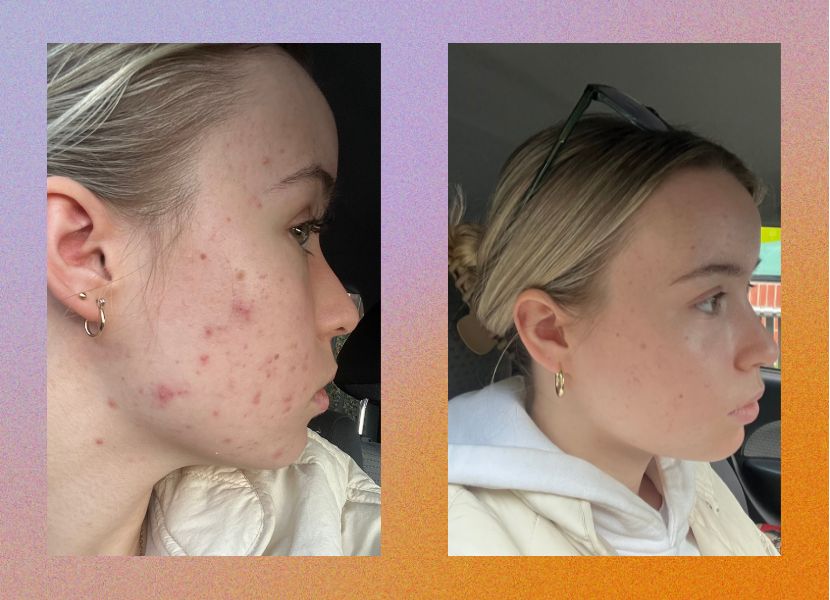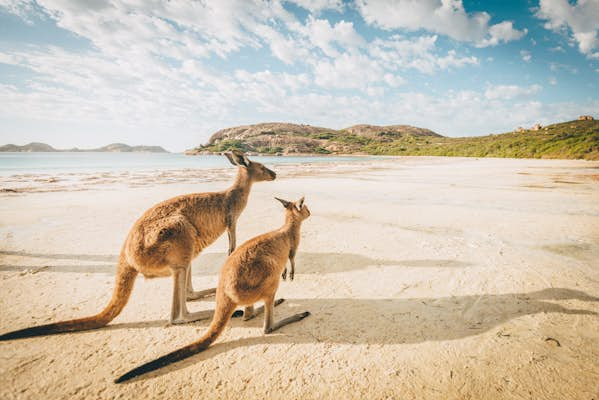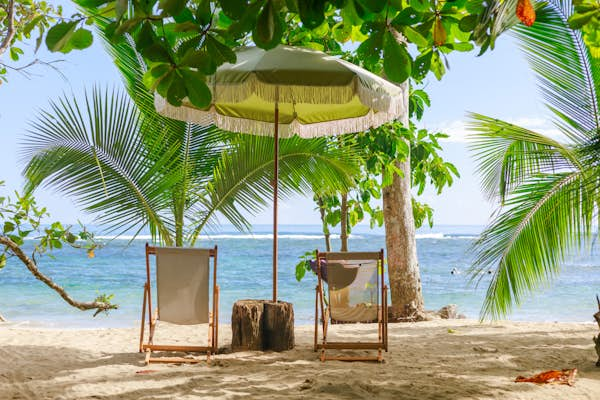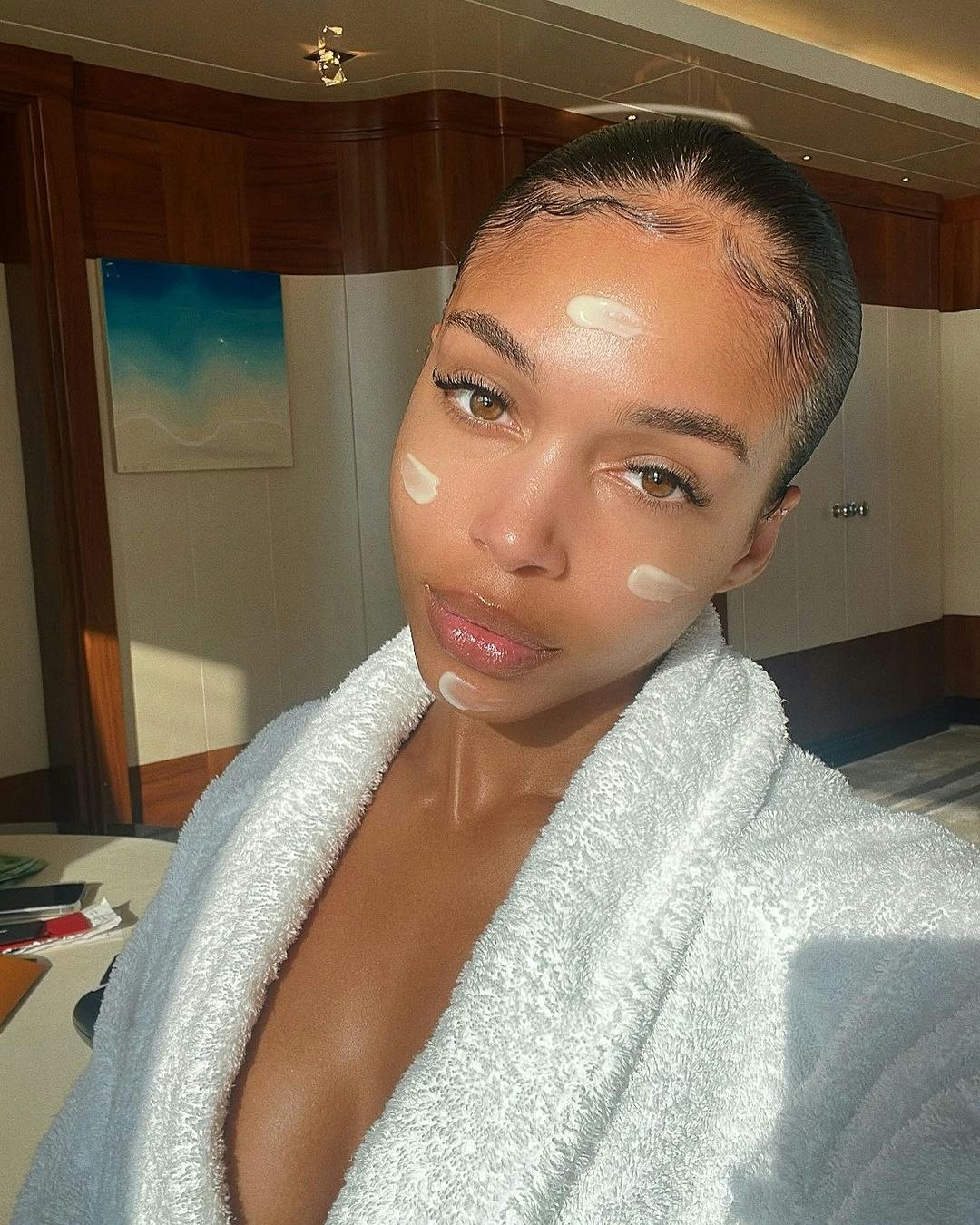


I gave up my skincare routine to see if it would fix my acne
What to try when you feel like you’ve tried everything.
I have struggled with acne since the day I hit puberty. In the over 10 years since, I’ve tried what feels like every treatment out there. I started with generic chemist finds, moved on to prescribed topical treatments and medications, then on to hormonal birth control before eventually resorting to two rather harrowing rounds of Roaccutane.
My skin, which is also incredibly sensitive (like, break out in a rash when I cry, sensitive), had been doing much better until a year or so ago when my acne flared up again. Rather painful and angry spots were once again sprawled across my face and despite my efforts, time and serious financial commitments, they wouldn’t budge.
We like nosy people. Don’t be shy, head to our Beauty section for more.
So, just over two months ago, feeling low on options, I decided to cut it all out. I said goodbye to my serums, oils and cleansers and committed to using only what felt like the bare minimum: a moisturiser, SPF and micellar water. For reference, I used the QV Face Oil-Free Moisturiser, the Bondi Sands Daily Moisturising Face SPF 50+, and the Garnier Skin Active Micellar Cleansing Water. I find these basics work for me, so it was a nice added bonus that I got a break from the higher-end ‘extras’ I was previously investing in.
After eight weeks of this routine, my face felt like it was finally calming down again. With the exception of some fun hormonal breakouts, my angry spots reduced to a bit of redness, some surface-level irritation and my pre-existing scarring.
As a bonus, my previously dull face felt more glowy than ever. If you’re feeling sceptical, take a look at these (slightly awkward because I didn’t initially take them for the public eye) before and afters.

Now I didn’t want to get ahead of myself, but I really did feel like I’d cracked some kind of code. Can less really be more? I spoke to Dr Shammi Theesan, founding dermatologist at Ode Dermatology, to find out.
Back to basics
“The way I would start is to strip back,” says Dr Shammi. “I would strictly only cleanse with a sphingolipid-rich, ceramide-rich, hyaluronic-rich cleanser.” For those with sensitive skin, she suggests using micellar water as an alternative, and looking into taking an antihistamine twice a day to really reduce any inflammation.
When stripping back on products, Dr Shammi recommends a basic routine consisting of a gentle, emollient-rich, glycerine or glycerol-based moisturiser with a zinc sunscreen on top, and only washing the face at night. “We need to teach our skin to optimise its own microbiome. It’s got a good cycling mechanism there, so we’re just trying to optimise that and not overload it with too many actives.”
But there are non-negotiables in skincare. Dr Shammi emphasises the importance of the cleanser/micellar water, moisturiser, SPF routine. If you’re going to add a skin active, she suggests a niacinamide or vitamin B3 product, noting each is “a very good starting point and overall multitasker for a skin active.”
Dr Shammi also emphasises the importance of gut health to maintain skin health. “Look into [the] reduction of processed foods, less sugar, less dairy, prebiotic supplementation, probiotic supplementation.” She adds that getting enough sleep and vitamin D are also relevant factors to consider when looking after your skin.
So, what’s doing more harm than good?
It’s important to note that some products can do more harm than good to skin with underlying issues, especially if not applied properly. She explains that overdoing certain products, even those marketed as skin saviours, can strip the skin’s microbiome. “Things that are skin-enhancing can sometimes include vitamin c and retinol, and you really don’t want to overload the skin or introduce actives like that without having prepped your skin.”
Dr Shammi recommends speaking with your doctor or dermatologist before applying new actives, which she adds, can ultimately cause breakouts. “These skin products can actually cause local inflammation and make your oil production worse,” she says.
If you find your skin feels dryer, redder or tighter after using a product, Dr Shammi suggests stripping usage back to only every few days.
She adds it’s also best to test products one at a time for a few weeks to decipher which, if any, might be causing inflammation. This way, you’ll know whether it’s a single product irritating your skin, or the combined interaction of products that don’t go well together.
A road to recovery
When reintroducing products, Dr Shammi suggests conducting a patch test first, applying a small amount of product on your inner arm, as it often mimics the skin on your face. If you do feel that a product is irritating, go back to your basic, non-negotiable routine, wait 28 days and then retest it.
Once you’re ready, consider using a smaller amount of product than usual, starting on your upper jaw or neck so as to not irritate your face. You could also try applying a thin film of glycerine or glycerol-based moisturiser and then using the new product on top. Another approach is to apply, then wipe off the product one night, then build up a tolerance each evening by leaving the product on slightly longer after each application.
Reflecting on the above, I’d say my little experiment was on the right track. With my fresh-feeling face and Dr Shammi’s advice, I’m ready to make small adjustments and start reintroducing some actives into my routine.
This article was originally published on October 10, 2022.
To discover more on Dr Shammi and the variety of acne therapies, head here.

The cutest animals in Australia and where to find them
Undoubtedly one of Australia’s biggest draws is its wildlife, which you’re almost guaranteed to see amidst the nation’s incredible landscapes (or in an animal sanctuary if you’re short on time). And despite the horror stories you may have heard, it’s not all deadly spiders, sharks and snakes (although you may see all three if you stay long enough). The roll call of unique animals – from super cute mammals to colorful birds and fish plus lizards and geckos you won’t see anywhere else – is long.
Australia offers many different wildlife-spotting experiences, depending on where you visit. However, some of even its most famous species are critically endangered, which means sightings are rare and conservation efforts are vital.
We’ve created the ultimate beginner’s guide that gives you the best chance of getting up close (but not so close that you put these wild creatures at risk) with Australia’s unique native animals.
Where are the best places for wildlife watching in Australia?
Your best chance of spying some Australian fauna will be in one of the 500+ national parks scattered across the country.
Some national parks are better set up for overseas visitors, with accommodation nearby and guides available for a wildlife-spotting tour. In the north, head to The Daintree (Queensland), Kakadu National Park (Northern Territory) or Cape Range National Park (Western Australia). In the southern states, put the Blue Mountains (New South Wales), Grampians (Gariwerd) National Park in Victoria and Cradle Mountain-Lake St Clair National Park in Tasmania on your must-visit list.
Many rural accommodations in Australia are embedded in nature, which means you may have emus, echidnas or wallabies wandering past your room.
But even a city-based trip Down Under offers opportunities for close-up wildlife encounters. Kangaroos inhabit the capital city of Canberra, koalas live in the Adelaide Hills, and the one-of-a-kind quokka is found on Wadjemup/Rottnest Island near Perth – and where do we begin with the birdlife in Sydney? If you want to see unique animals, you’ve come to the right place.

Where are the best places in Australia to see koalas, kangaroos and other iconic species?
Koalas
Koalas need no introduction. The poster child for “super cute Australian animals,” koalas spend around 20 hours a day fast asleep. If you’re going to see a koala on the move, clumsily crabbing along the ground from one tree to the next, it’s most likely at night. Otherwise, they’re usually perched in the crook of a tree munching on eucalyptus leaves alone or with a joey clinging on. You can spot these adorable tufty-eared marsupials in forests close to the coast in southeastern Australia. However, human encroachment has put koalas on the endangered list in NSW, the Australian Capital Territory and Queensland.
Where to find them: Stands of trees along the Great Ocean Road (Victoria), on Magnetic Island and Stradbroke Island/Minjerribah (Queensland), and on Kangaroo Island (South Australia) are known by locals to house koalas – you’ll have to ask around. Some wildlife parks allow visitors to take a photo with a koala, but cuddling one is a controversial practice that’s illegal in most states because it causes stress to the animals.
Tips for spotting them: Koalas are noise-sensitive – a quiet approach through the forest is required. If you look carefully at higher branches (binoculars may help), you may spot one attached to a tree limb. You’ll find it easier to spot one if they’re munching or moving around so try early in the morning or at dusk when it’s cooler.

Kangaroos and wallabies
First, how do you know which is which? Both kangaroos and wallabies are marsupials that belong to a small group of animals called macropods (yes, that’s Latin for “big feet”). Kangaroos are larger; they’re usually one color; they use their tails like a fifth foot (which also means they jump further); and are often bounding through open grasslands. Wallabies, on the other hand, are smaller (25kg compared to a 90kg kangaroo) and their color can vary, like the black-footed rock wallaby, which helps them camouflage in forests or on rocky escarpments where they typically live.
Where to find them: Kangaroos live in many parts of Australia, they’re even been spotted on suburban streets and golf courses at dusk. One of the most iconic places to see kangaroos is on the white-sand beaches of Lucky Bay in Cape Le Grand National Park (Western Australia). Wallabies can be shier and they stick to smaller groups, but different species are found in national parks such as Narawntapu National Park (Tasmania) and Cape Hillsborough National Park (Queensland).
Tips for spotting them: Dawn and dusk are the best times to see kangaroos and wallabies. Don’t make any sudden moves, as they spook easily. And if you do get close, definitely don’t feed them.

Wombats
Perhaps not as well known outside Australia, wombats are beloved by locals. They feature in Aboriginal Dreaming stories, as well as classic Australian children’s literature. The word “wombat” is believed to come from the Dharug language of the Aboriginal people, the Traditional Custodians of the Sydney area (as does koala and wallaby). These gentle furry marsupials are around as big as a medium-sized dog – but with smaller legs and a stout body – and they hide out in burrows by day, foraging for food by night. A classic piece of pub quiz trivia is the fact wombat poo is cube-shaped. If you see some, you know one is close.
Where to find them: The best places to spot wombats include the Bay of Fires, Cradle Mountain-Lake St Clair National Park, and Flinders or Maria islands (Tasmania); Wilsons Promontory National Park (Victoria) and the Blue Mountains (NSW). Unfortunately, the northern hairy-nosed wombat is critically endangered – only a small population of around 300 remains in a protected area of Queensland.
Tips for spotting them: Dawn and dusk are your best times to spot wombats, as they hibernate during the heat of the day, but if you’re camping at a national park you may see (or hear) them out overnight.

Echidnas
You’ll bump into these short-beaked spiny creatures in national parks but even in bushland areas close to the city. Those sharp-looking spines, which protect echidnas from predators like birds of prey and larger mammals, are actually hairs with extra keratin. When frightened, an echidna will tuck its snout and legs under and curl into a spiky ball. Even though they look similar, echidnas have more in common with the platypus (another egg-laying mammal in Australia, read on!) than the common hedgehog. And here’s another cute fact: a baby echidna is called a “puggle”.
Where to find them: You’ve got a good chance of seeing an echidna in southern states like Victoria, NSW, South Australia, ACT, Tasmania and southwest WA, where there’s plenty of forests, shrubland and insects for them to live on.
Tips for spotting them: In summer echidnas are out foraging around dawn and dusk, but in cooler seasons you may spot one in the day. They’re shy, slow-moving creatures so keep still if one waddles into your path – it will change course if it hears you. Small holes in the ground are often a sign an echidna has been foraging for ants and termites nearby.
Crocodiles
Two types of crocodiles live in tropical Australia: saltwater and freshwater crocs. “Salties,” as Australians call them, are found in estuaries and rivers by the coast as well as in the sea. Male saltwater crocodiles can grow to 6-7 meters (20ft to 23ft) although most are closer to 4 meters (13ft). “Freshies” are smaller (2m/6.5ft) and less aggressive, but if they’re feeling threatened, their bite is dangerous.
Crocodiles were hunted in Australia until the 1970s when they became a protected species. A direct encounter with a crocodile will likely kill you, so follow all instructions from your guide. Never – ever – enter a body of water in northern Australia unless you are absolutely sure it is crocodile-free, and read up on staying safe in crocodile regions.
Where to find them: Crocodiles live in the northern parts of Australia. To see saltwater crocodiles in the wild head to Adelaide River and Kakadu National Park (Northern Territory) and the Daintree River (Queensland). Freshwater crocodiles can be seen at Nitmiluk (Katherine Gorge) and Litchfield national parks (Northern Territory), plus Lake Argyle and Bandilngan (Windjana Gorge) National Park in Western Australia.
Tips for spotting them: The dry season (May to October) is the best time to see crocs as they’ll be concentrated near water sources or basking in the sun on a river bank. They can be hard to spot in water as they usually float with only their eyes and snout breaching the surface. Look for slide marks on river banks or a distinctive V-shaped wake in water.

Emus
These large flightless birds (second only to the ostrich) live in various spots across Australia except in Tasmania. They are often running along wide open plains in search of food and water, and avoiding predators (they can reach speeds of 50kph/30mph). For many Aboriginal Australians, the emu has an important role in mythologies and is a key creator spirit. Look up and you will see the Emu in the Sky, a constellation made of the dark areas of the Milky Way.
Where to find them: You’ll find emus on grassy plains in Kosciuszko National Park (NSW), on open savanna in Murray Sunset National Park (Victoria) and in many outback regions. As they are not aggressive animals, they also often inhabit city-based wildlife parks.
Tips for spotting them: Emus can be seen in groups if there’s a water source nearby, but you may spot one on its own. In areas where there are lots of tourists they may have been hand-fed which can make them more aggressive, particularly about getting food – always keep your distance. As a child, this animal lover was nipped by one at Healesville Sanctuary (which was more of a shock than anything else).
Tasmanian Devils
You know the Looney Tunes cartoon character Taz, the Tasmanian Devil? Well, these cute carnivorous marsupials are also endangered, due to the fatal and transmissible Devil Facial Tumor Disease (DFTD) that has killed 80% of the population. A disease-free colony has been established on Maria Island (off the Tasmanian mainland) and scientists have been testing a vaccine inspired by the way the SARS-CoV-2 vaccine works.
Where to find them: Tasmanian Devils have been spotted at Cradle Mountain-Lake St Clair National Park, Narawntapu National Park and Mount William National Park, but you’re more likely to see one in a wildlife park in a special nocturnal exhibit where you will also learn more about Tasmania’s conservation efforts.
Tips for spotting them: Tasmanian Devils are nocturnal scavengers (they will munch through carrion from the side of a road, with a bite as strong as a hyena) so be careful driving after dark. Going on a guided nighttime tour will increase your chances of seeing one in the wild.

Platypus
Their reputation for the unexpected precedes them. In the 19th century, naturalists back in England thought a platypus specimen must be a hoax with its duck-like bill, otter-like body, beaver-like tail, webbed feet, sharp claws and venomous spurs. This egg-laying mammal is unique to Australia, and while seeing one in the wild will take patience and luck, they are real. Apart from admiring their representation on Australia’s 20c coin, many zoos and wildlife parks have nocturnal platypus enclosures where you can view them burrowing and swimming underwater.
Where to find them: The Atherton Tablelands is the most iconic spot for platypus sightings – ask at a local tourist office for recommended spots. In Eungella National Park, special viewing platforms have been integrated into the forest around Broken River, one of this elusive monotreme’s favorite habitats.
Tips for spotting them: Patience is the key – set yourself up quietly and comfortably and look for telltale trails of bubbles on the water’s surface. Chances are the bubbles will be followed by a surfacing platypus. Don’t startle them – platypuses are notoriously shy and will dive back underwater in the twinkling of an eye and take refuge in a riverside burrow if they sense danger.

Quokkas
These marsupials are so photogenic that the “quokka selfie” became an online trend – until animal welfare experts spoke up. These small wallaby-like marsupials may look like they’re happy but that smile is really a quirk of the quokka’s facial structure, not permission to put a camera in their face. Quokkas are non-aggressive – docile even – which adds to the anthropomorphizing by humans. They also climb trees, hop like rabbits and sleep in the daytime. Quokkas are listed as “vulnerable” due to habitat loss as well as the arrival of predators (humans shamefully were on that list).
Where to find them: Quokkas are found on Wadjemup/Rottnest Island in Western Australia, a 30-minute ferry journey from Fremantle south of Perth.
Tips for spotting them: Quokkas are nocturnal, although in the winter months, they can be active during daylight hours. Get away from other tourists by foot or bike to increase your opportunity for a chance encounter, or book a guided walking tour. The Rottnest Voluntary Guides Association runs a “Meet the Quokkas” walking tour daily, where visitors are asked to observe from a respectful distance.
For visitors short on time, consider visiting a wildlife sanctuary
Sightings are never guaranteed when you’re dealing with wildlife, so if your trip Down Under won’t be complete without a koala, there are myriad wildlife reserves and zoos in Australia where native (and non-native) animals are in residence.
Yes, there’s a strong animal welfare case for never visiting animals in captivity, but many in Australia do adhere to strict animal welfare protocols and contribute to education and conservation efforts (do your research and you can be the judge).

10 Tattoo Artists You Need to Follow on Instagram
Swifties had a lot of opinions about Taylor Swift’s rocky relationship with pop star Matt Healy, and yet, he makes a number of appearances in her new album. Here’s a play-by-play of their short-lived romance, ranging from the couple’s beginning to their breakup to Healy’s post-TTPD drop reaction.

Serenity now: 5 days in Caribe Sur, Costa Rica
Caribe Sur, on the very southern tip of Costa Rica’s Caribbean coast might be my top mentally-I’m-here places. Its the exact location I pictured as a teenager when I dreamed about a life centered on surfing and sun and bicycles.
This area starts in Puerto Viejo de Talamanca (where the party is) and ends in Manzanillo. You’ll find a string of stunning, secluded beaches between these two endpoints, perfect for walking, hiking and simply wandering.
The culture here feels slightly different from the rest of Costa Rica – residents still live by a pura vida ethos and tico time definitely reigns supreme (my favorite thing ever), but there is a distinct Indigenous influence and a definite Afro-Caribbean culture. It’s not the easiest place to get to, but if you’re looking for adventure with a side of pura vida, this is the place.
And here’s the thing: you’ve got options. Spend the entire trip sitting on the deck of your bungalow staring into the rainforest and making friends with the monkeys, or dive into adventure headfirst.
Grab your flip-flops and a bathing suit and hop on this banana bike, ’cause we’re going to the jungle.

Here’s the nitty gritty:
Where to fly into: You’ll want to book your flight into Puerto Limón. You can fly into San Jose, but the drive is long and kind of treacherous. Limón is only an hour away from Puerto Viejo de Talamanca.
How to get from the airport: Rent a car or book a shuttle. The cheapest option is a bus, which takes about two hours; a shuttle or car will take you 50 minutes. If you’re staying at Hotel Aguas Claras (see below), they’ll arrange transportation for you.
Getting around: Renting a car is nice, but you don’t really need wheels in this part of the world. Sights are spread out, but there are plenty of taxis and everyone rides bikes (which is by far the most fun way to get around).
Where to stay: Personally, I don’t care if I’m right on the beach or not – the jungle is just as wonderful as the sea. I like to book a vacation rental near Playa Chiquita or Punta Uva, both great places for a base, but if you want a hotel, book Hotel Aguas Claras. This gorgeous collection of beach bungalows is owned by long-time resident and artist Elizabeth Steinworth, and as she says, it’s a place for artists, doers and tinkerers. Like most things in this precious corner of the world, it was created with the environment in mind, so your surroundings feel as natural as if the earth had created it itself. And you’ll be enchanted with Playa Chiquita just steps from your door.
When to go: April is the prime nesting season for green turtles, and I promise it’s an experience you don’t want to miss. But if surfing is more your thing, you’ll catch the best swells December through March.

Day 1
Arrive: I usually arrive in the afternoon and settle in, taking a deep breath and remembering I’m on tico time now. Sometimes I head straight to the beach for a swim and a short walk, but usually I just sit on the deck and take in the environment – the spider monkeys tend to swing through in the afternoon, and the howlers come a bit later. The first time I heard a howler monkey I was convinced I was about to be eaten by a mythological monster, but their roar is bigger than they are. They sometimes like throwing things down from above, so watch your head.
Happy Hour: DaLime Beach Club on the Hotel Aguas Clara’s property is the perfect spot for happy hour before they close at 5 – the cocktails are divine, but my favorite is the Hibiscus tonic (I’m a mocktail girly). They often play reggae tunes, great for settling into the laid-back vibes.
Dinner: When I’m hungry, I head to Papaya, the on-site restaurant at Hotel Aguas Claras. First, let’s talk aesthetics. Pops of pink and orange among the natural wood – did they take design tips from my dreams? Second, let’s talk food. It’s local, organic and it’s healthy, fitting right in with all the things I love about coming to Caribe Sur. The menu is ever-changing, and I’m never disappointed.

Day 2
Morning: I am a breakfast person, and since we don’t have much planned until the evening, I’m going to go to Gypsea Cafe in Playa Chiquita because the coffee is delicious and the benedicts are decadent.
Spend the day: I like to spend at least one day wandering the beaches from Playa Chiquita to Punta Uva. There are several isolated coves along the way, so I stop and relax when I find a spot I like. I’ll swim and lay in the sand under a palm tree before continuing on to the next one. I bring a water bottle and a quick-dry towel in my backpack, and I’m ready to explore.
Dinner: Since I brunched and skipped lunch, I enjoy an early dinner at Selvin’s, the top Caribbean spot in the area. Sometimes I order something with shrimp, but I just as often get the Chicken Caribeňo which I crave when I’m not in Caribe Sur.
After dark: Now for a trip highlight. Before you arrive, book a turtle-watching tour in Gandoca. The Refugio Nacional de Vida Silvestre Gandoca-Manzanillo stretches from just south of Playa Chiquita in Manzanillo, all the way to the border with Panama, and it’s a haven for green sea turtles, as well as green macaws, jaguars and other incredible wildlife. The van picks you up in the early evening, and the drive is about 45 minutes around the refuge to the beach in Gandoca. (Side note: Gandoca is not at all touristy and worth a daytime tour.) But for now, here’s what you need to know.
- Wear long sleeves, long pants, socks and shoes. You want to be totally covered to protect yourself from bugs. Dark clothes are preferred.
- You aren’t allowed flashlights unless they have a red light. The guide will have one.
- No cameras. This is an enjoy and remember experience.
There is a quiet, meditative feeling that washes over me when I watch a turtle lay her eggs – the turtle’s process is slow, and my breath slows to match her pace. It is incredibly intimate, not something you often feel with wildlife. The process can take up to three hours. There are no words to match the excitement you’ll feel on the drive back to the hotel.

Day 3
Morning: After sleeping off my incredible late night its time to ride a banana bike up to Playa Cocles for the day. I go straight to Caribeans Chocolate and Coffee for, you guessed it, chocolate and coffee before finding a spot on the beach.
Spend the day: The waves here are just right for beginner surfers, and though I have been trying to surf for more years than I will mention here, I am still an absolute beginner. You can rent boards here and book lessons too. I’ll probably snag lunch at Sage, the beach restaurant at Playa Beachfront Hostel, a convenient stop because I can cruise up in bare feet and a bathing suit, order Caribbean rice and beans, and hang for the afternoon.
Dinner: After a shower and a quick change into an easy, breezy sundress, it’s time for dinner at El Refugio. I absolutely love diving into gorgeous plates of food under the stars in the garden of this steakhouse run by a husband-and-wife duo from Argentina.

Day 4
Morning: Since I’m usually staying at a home rental, I’ll grab a light breakfast; either fruit I picked up from the farm stand or quick rice and eggs. But if you’re at a hotel, just choose something light from the hotel restaurant before snagging a banana bike and heading out on an easy 4-mile ride to Manzanillo.
Spend the day: Diving for lobsters. You can pre-book with l0cal chef Andy Cook Campbell who owns the Cool & Calm Cafe in Manzanillo. He’ll load you in his boat, help you free dive for lobsters and then take you to a secluded beach to enjoy your catch. Other, more budget-friendly options include kayaking down the protected waters of the coast or my favorite choice, hiking in the Refugio Nacional de Vida Silvestre Gandoca-Manzanillo – the easy coastal trail is about 3 and a half miles. With the rainforest on one side and the ocean on the other, the experience is immersive. Then, sneak in a quick swim at Tom’s Bay and head back to Manzanillo.
Afternoon: If I haven’t booked a lobster tour with Andy, I’ll grab a meal at his Cool & Calm Cafe, an open-air, rasta-themed restaurant right at the entrance to Manzanillo.
Later: If you’re a book-and-bed type like me,grab a light dinner at Arrecife , which is right on the beach in Punta Uva and enjoy one last evening peacefully soaking in the jungle sounds. But, if you’re up for beats on the beach, head to Puerto Viejo de Talamanca: Jonny’s Place and Hot Rocks are both wildly popular and ridiculously fun.

Day 5
Wake up. Enjoy one more plate of fresh fruit and an amazing coffee, and take one more dip in the sea. But now we say goodbye and head back to real life. Until next time, Caribe Sur.
Keep planning your trip to Costa Rica:
Enjoy the sea breeze at Costa Rica’s 8 best beaches
The kiddos will have a blast with these family-oriented activities
All the things you need to know before visiting the land of pura vida
Keep your wallet happy with these budget tips

9 experiences you shouldn’t miss in Slovakia
An independent country only since 1993, Slovakia nonetheless is steeped in history, evident in its ancient towns, medieval castles and deep-rooted traditions.
With just over 5 million citizens, the diminutive nation bursts with lesser-known treasures that promise to surprise and delight even the most seasoned travelers. From subterranean wonders to majestic mountains, fairy-tale castles to inspiring national parks, Slovakia offers a wealth of adventures and unique cultural experiences.
Here’s our list of the best things to do in this Central European gem.
1. Wander through mystical Slovenský Raj National Park
Its name translating to “Slovak Paradise National Park,” this reserve is a haven for nature enthusiasts. Its network of hiking trails meanders through dense fir forests, filling the air with a sweet fragrance and a touch of woodiness that reminds you of your Christmas tree. The trails weave through deep gorges and past cascading waterfalls, often requiring you to navigate ladders and chains, adding an element of adventure to your trek.
Detour: While exploring the park, don’t miss the nearby Dobšinská Ice Cave, one of the largest such caverns in Europe, where glistening ice formations and ethereal blue hues create a surreal underground world. Open from mid-May to mid-September, this cave offers a cool retreat from the summer heat.

2. Take in Bratislava’s architecture and sample Slovak cuisine
Adjoining both Austria and Hungary, Bratislava is the only capital in the world that borders two other sovereign states. Yet the variety of structures within its city limits make this city unique.
In the Old Town (Staré Mesto), cobblestone streets lead to architectural delights like the Gothic St Martin’s Cathedral, the art nouveau Blue Church and the neoclassical Primate’s Palace. While exploring the historical landmarks of the Main Square (Hlavné Námestie), enjoy stunning views of the city from the Old Town Hall tower (Stará Radnica). After all the sightseeing, seek out a traditional restaurant to tuck into traditional Slovak dishes like bryndzové halušky (potato dumplings with sheep cheese) and kapustnica (sauerkraut soup).
Detour: The UFO Observation Deck on the SNP Bridge boasts the best panoramic views of the old town, Bratislava Castle and the Danube. You can savor fine dining in its restaurant while waiting for the sunset; the adventurous will love the thrilling 85m(180ft)-high skywalk.

3. Step back in time by castle-hopping
Slovakia beckons medieval and Renaissance architecture enthusiasts with its wealth of castles, chateaux and manor houses. Dating back to the 12th century, Spiš Castle in the east is one of Central Europe’s largest and most impressive complexes.
With its fairy-tale ambience, Bojnice Castle is especially enchanting when covered in snow in winter. Lush gardens surround this romantic, neo-Gothic pile; it even boasts a zoo, making it a perfect family destination.
Another must-see is Orava Castle, built on the site of an older wooden fort after the Tartar invasion in 1241. Perched on a high rock above the Orava River, it offers remarkable views across rolling hills, forests, charming villages and distant mountains.
Planning tip: The castles come to life during many annual events and festivals, such as the International Festival of Ghosts and Spirits at Bojnice, held during April and May.

4. Descend into Slovakia’s underground wonderlands
Slovakia is a delight on the surface – but more gems are hidden underground. There are in fact over 7000 caves within Slovakia, and 45 of them are currently freely open to the public, most of them in Slovak Karst National Park.
Domica Cave, part of a 15km(15.5-mile)-long cave system that ends in Hungary, is famous for its stunning stalactite formations and underground river, which you can explore by boat. Ochtinská Aragonite Cave is one of only three caves featuring rare and almost sculptural Aragonite formations, offering a surreal underground experience.
Harmanecká Jaskyňa cave boasts bulky domes, chimneys and abysses shining in rare white soft sinter (also called “rockmilk”). So far, explorers have discovered 2763m (9065ft) of cave corridors here; the sightseeing route is just over 1km (.6 miles) long and takes about 60 minutes.
Planning tip: Wear comfortable shoes and a jacket, as the caves maintain a cool temperature year-round.

5. Learn about mining history in Banská Štiavnica
Nestled in the hills of central Slovakia, Banská Štiavnica boasts a rich gold- and silver-mining heritage dating back to the 12th century. Its narrow, winding streets lead to charming squares and hidden courtyards, while historical buildings, including elegant townhouses, churches and public buildings with colorful facades and ornate frescoes, showcase its architectural beauty.
The world’s first technical university, the Mining Academy, opened here in 1762, significantly advancing knowledge related to mining and metallurgy. Don’t miss out on exploring the tajchy, a sophisticated system of artificial water reservoirs built to support mining operations – a stellar example of town’s unique charm and ingenuity.
Detour: Climb Calvary Hill for a rewarding view of the town. Its slopes are dotted with chapels and crosses, creating a serene and spiritual atmosphere.
6. Sip and swirl wine in the vineyards of the Small Carpathians
With its 12 viticultural zones, the Small Carpathians Wine Region is a must-visit for anyone who appreciates fine reds, whites and bubblies. In the heart of the region, the vineyards of Modra produce grapes that go into the spicy Veltlínske Zelené (Grüner Veltliner), the crisp green apple and citrus notes of Rizling Vlašský (Welschriesling) and the earthy, minerality of Frankovka Modrá (Blaufränkisch). Along the region’s wine route, you can enjoy guided tours and tastings that truly showcase the best of Slovakia’s oldest wine region.
If beer is more your style, seek out a few of Slovakia’s acclaimed microbreweries. In particular, don’t miss Erb Brewery in Banská Štiavnica, featured in Lonely Planet’s Global Beer Tour.
Planning tip: During the harvest festivals every September, expect lively celebrations that bring together music, food and wine. The autumn vineyards offer up glorious colors – from golden yellows to fiery oranges, deep reds, persistent greens and earthy browns – all set against the natural landscape.
You’ll also see locals adorned in vibrant folk costumes with intricate patterns. Women don embroidered blouses, wide skirts and colorful headscarves, while men sport embroidered shirts, broad belts and trousers with decorative trim.

7. Learn about Čičmany’s artisanal heritage
Nestled in the hills of northern Slovakia’s Žilina region, Čičmany is a picturesque village renowned for its unique “Chichman pattern” that can be seen on beautifully preserved wooden houses, some over 200 years old. This intricate design originates from traditional folk art and decorates textiles, clothing and household items as well as house exteriors.
Artisans uphold this practice by crafting various items such as embroidery, garments, pillows and bedspreads, highlighting the pattern’s enduring beauty through generations. Explore the local museum to uncover the history and significance of these decorations.
Planning tip: Visit during Čičmany’s summer folk festivals, which feature traditional music, dance and crafts – then explore the tranquil countryside, ideal for hiking.
8. Bask in the thermal waters of Piešťany
For a relaxing retreat, head to Piešťany, a spa town renowned for its therapeutic thermal springs and mud baths. After long days of hiking in the Tatras, you can savor the healing properties of the mineral-rich waters amid beautifully landscaped parks. The spa’s geothermal water soothes muscles and promotes relaxation, while the sulfuric scent mingles with fresh air, enhancing the therapeutic ambience.
Planning tip: To ensure availability, book treatments in advance, especially during peak season.

9. Ascend up the High Tatras, Slovakia’s treasures
Slovakia’s tallest mountain range, the High Tatras are a paradise for outdoor enthusiasts. Whether you’re into hiking, skiing or simply soaking in magnificent views, these mountains offer year-round activities, mountain scenery, clear alpine lakes and abundant wildlife. The network of hiking trails caters to all levels, from gentle walks to challenging ascents. A must-do hike is to the glacial Štrbské Pleso lake, a serene spot surrounded by dramatic peaks.
Planning tip: For a quieter experience, consider visiting in late spring or early autumn, when the trails are less crowded and the weather is ideal for hiking. You might even spot a foraging bear.



